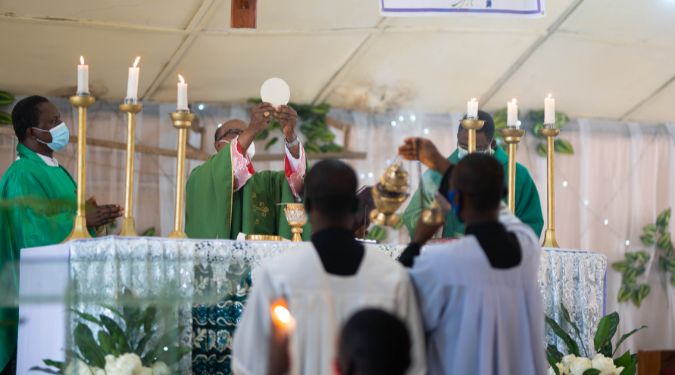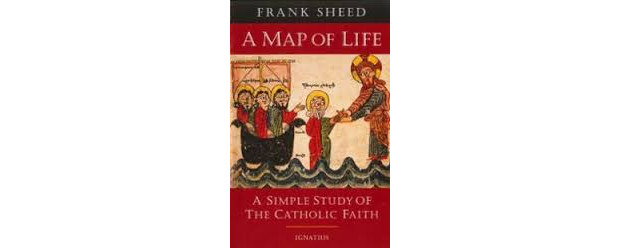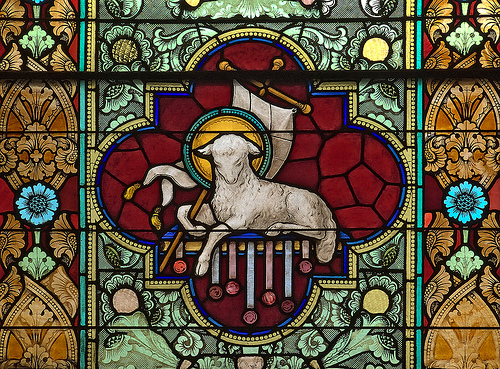Where did the Church get the idea that what looks like bread and wine in the Eucharist is actually the Body and Blood of Jesus? When and where did Jesus teach this in Scripture?
Catholics can turn to the sixth chapter of the Gospel of John for the answers. This chapter starts out with Jesus miraculously feeding thousands and then moves to a synagogue where Jesus claims to be “the Bread of Life” ( John 6:35 and 48) and where He says, “unless you eat the flesh of the Son of man …, you have no life in you.” (John 6:53)
Some say Jesus merely spoke symbolically here, and that “eating his flesh” really means to listen and obey his words. Can this be true? No, and to help us understand this, we should ask ourselves these six questions:
1) How did His original listeners interpret His words?
In John 6:52 his Jewish listeners ask, “…How can this man give us his flesh to eat?” and in John 6:60: his own disciples ask, “…This is a hard saying; who can listen to it?” It is clear that these people understood him literally. They took him so literally that many of these followers left him immediately: “After this many of his disciples drew back and no longer went about with him.” (John 6:66)
2) Did Jesus correct their “misunderstanding”?
If Jesus were speaking figuratively about his flesh being bread, then obviously his disciples – people that had been following him for some time – were terribly mistaken. Did Jesus do anything to correct them? No! Why not? Because they understood him perfectly! If he were speaking figuratively, he would have corrected their misunderstanding because staying or leaving was a matter of life or death. In fact, this is the only time in the New Testament that disciples left him over a doctrinal issue. Jesus certainly would have stopped them because he stated, “…him who comes to me I will not cast out…and this is the will of him who sent me, that I should lose nothing of all that he has given me, but raise it up on the last day.” (John 6:37-39)
3) Is “eating another’s flesh” ever used figuratively in Scripture?
Yes, and whenever this is used as a figure of speech elsewhere in Scripture it always means “to persecute, assault, oppress or destroy another.” See Psalm 27:2, Isaiah 9:18-20, Micah 3:3, 2 Samuel 23:15-17 and Revelation 17:6,16. Would Jesus use these words in a figurative sense to express intimacy? Try saying, “Unless you assault me you have no life in you.” No, it doesn’t work.
4) Did Jesus ever speak of Himself figuratively?
Yes, and every time he did so, he either explained his meaning to his disciples or made his meaning clear from context. For instance: “I am the true Vine.” (John 15:1) and “I am the Door.” (John 10:9) Jesus’ disciples didn’t ask, “How can this man be a vine?” Nor did they ask, “How can this man be a door?” In other words, they understood him to be speaking figuratively from the context. John himself states that Jesus was speaking figuratively or in parables before he said that he was the Door (John 10:6).
5) Can the original Greek shed light Jesus’ words?
Yes. Jesus uses two Greek words for “eat” in John 6. The first word is φάγω, which transliterated into English is “phago” and is pronounced “FAG-o”. It means “to eat” and is seen in various forms in John 6:49,50,51,52,53, and 58. Now “eat” could be taken physically or symbolically, but once the murmuring starts, Jesus switches to a more physical verb, “τρώγω”, which is transliterated into English as “trógó and is pronounced “TRO-go”. This word means to gnaw or to munch and is seen in John 6: 54,56,57,58. The author of this Gospel thought these Greek words accurately translated the actual Aramaic words that Jesus spoke. “Gnawing” is physical, and would be more difficult for anyone to take figuratively.
6) Did the Early Church interpret John 6 literally?
Yes! First, we must consider the words of St. Paul to the church in Corinth, “Is not the cup of blessing we bless a sharing in the blood of Christ? And is not the bread we break a sharing in the body of Christ?” (1 Corinthians 10:16) Or again, when he quotes Jesus: “This is my body, which is for you. Do this in remembrance of me.” (1 Corinthians 11:23-30) The early church maintained this perspective, as we see from St. Ignatius of Antioch (110 AD), who wrote: “…the Eucharist is the Flesh of our Savior Jesus Christ…” St. Justin Martyr (150 AD) wrote: “…the Eucharist…is both the Flesh and Blood of that incarnated Jesus.”
In short, in the sixth chapter of the Gospel of John, Jesus began to explain how he intended to feed his Church in the future. Let’s meditate on his words and may our faith in the body, blood, soul and divinity of Christ in the Eucharist increase.



